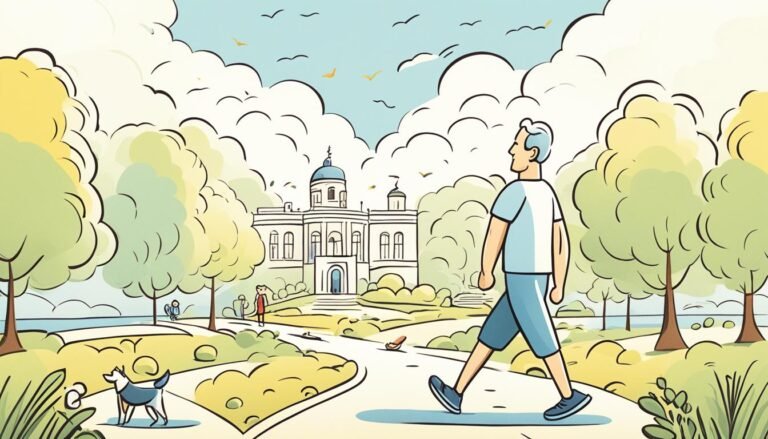The Practice of Gratitude: Cultivating Appreciation for Life’s Blessings
“Gratitude makes sense of our past, brings peace for today, and creates a vision for tomorrow.” – Melody Beattie
Start your journey of gratitude now. In a world full of challenges, gratitude is like a light in the darkness. It leads to deep happiness by showing us the good things we have. These include inner peace and joy.
Gratitude changes how we see the world. Instead of focusing on what we lack, we see what we have. This shift can bring beauty and wealth into our daily lives.
This article will look at different aspects of gratitude. We will see how it makes our lives better. From learning the benefits to daily gratitude tasks, we will cover it all. Let’s start this journey towards thankfulness, self-reflection, and personal growth.
Key Takeaways:
- Gratitude has the power to make sense of our past, bring peace in the present, and create a vision for the future.
- The practice of gratitude cultivates appreciation for life’s blessings and allows us to shift our focus from lack to abundance.
- This article will explore the benefits of gratitude and provide practical gratitude practices to enhance overall well-being.
Understanding the Power of Gratitude
Gratitude can change our lives for the better. When we focus on what we’re thankful for, our minds see the good more. It’s about seeing and thanking for the positives, no matter how big or small.
Gratitude has many benefits. It boosts mental health, makes us happier, and reduces stress. It helps us have a more positive life view.
There are many ways to practice gratitude. Keeping a gratitude journal is an easy one. Writing what we’re thankful for every day helps us focus on the good.
Practicing gratitude is like planting seeds of positivity. The more we nurture them, the more they grow and flourish in our lives.
Being mindful helps with gratitude. It makes us notice the good around us more. Grateful mindfulness lets us enjoy the small things more.
Thanking others is also big. It strengthens relationships and makes us feel more connected. Saying thanks in any way makes both sides feel great.
Making gratitude a habit takes work. It’s not always easy but well worth it. Gratitude can make us feel more joy and fulfillment, even in hard times.
Practical Tips for Cultivating Gratitude:
- Start a gratitude journal and write down three things you are grateful for each day.
- Practice mindfulness by taking a few moments each day to notice and appreciate the present moment.
- Express gratitude towards others through kind words, acts of service, or small gestures of appreciation.
- Count your blessings and remind yourself of the things you often take for granted.
- Create daily rituals or habits that remind you to cultivate gratitude, such as saying a gratitude prayer or reflecting on the day’s blessings before bed.
Cultivating gratitude is ongoing. The more we do it, the more it’s just part of us. Living in gratitude brings more positivity and happiness into our lives.
Expressing Gratitude Through Words
Saying thank you is very powerful. It helps us build strong relationships and see the good in life. When we thank someone for their kindness or help, it makes a big difference. Speaking words of gratitude can truly change how we feel and connect with others.
Ways to Express Gratitude
There are many ways to say thank you with words. Here are a few simple yet powerful ideas:
- Thank you notes: Write heartfelt notes to those who matter. Let them know you appreciate their kindness.
- Verbal appreciation: A direct, sincere thank you to their face goes a long way. It shows you truly care.
- Compliments: Give real compliments that point out the good in others. It brightens their day.
- Gratitude journal: Write daily about what you’re thankful for. It keeps you focused on the positive.
- Public praise: In the right places, mention someone’s good work. Let others know about their positive impact.
The Importance of Gratitude Practices
“Gratitude is not only the greatest of virtues but the parent of all others.” – Marcus Tullius Cicero
Gratitude changes our lives for the better. It turns our focus from what’s missing to what we have. When we talk about what we’re thankful for, we welcome more good things in our lives.
Showing thanks doesn’t just help us. It makes others feel valued and part of something good. By choosing to be grateful in our words, we make the world a better place. It’s a simple way to spread joy and kindness.
The Role of Gratitude Journaling
Gratitude journaling is a powerful way to improve our mindset. We do this by writing down moments of thanks. It’s a simple habit but very effective.
This journal reminds us of our many overlooked blessings. By focusing on the good, our minds move from negative to positive. Documenting these moments helps us train our minds well.
Choosing the right format is key when starting a gratitude journal. You might like a paper notebook, or you might prefer an app. Pick what feels best to you. This ensures you stick with the habit.
“Gratitude journaling allows us to reflect on the good things in our lives, no matter how big or small, and cultivates a positive outlook,” says Dr. Emily Torres, a renowned psychologist.
Our gratitude journal is a special place for reflection. It lets us see the riches in our life, even when times are tough. Writing what we’re thankful for daily boosts our appreciation for life.
Gratitude journaling not only lifts our spirits but also makes us proactive. Looking back at old entries shows our progress. It encourages finding new things to be thankful for, promoting a positive loop and growth.
The Benefits of Gratitude Journaling:
- Enhanced mindfulness: It makes us more aware of the now and grows our appreciation.
- Improved mental health: This practice lowers stress, anxiety, and depression, improving mental health.
- Increased resilience: Gratitude helps us stay positive and recover quickly from setbacks.
- Strengthened relationships: It deepens our bonds with others and makes us value our connections more.
- Heightened self-awareness: Journaling helps us understand ourselves better, leading to personal growth.
Start journaling today and see how it changes your view on life.
Cultivating Gratitude in Relationships
Gratitude goes a long way in making our connections stronger and more meaningful. When we thank others, it deepens our bond with them, fostering a sense of togetherness.
Telling your loved ones you’re grateful is a simple yet effective way to show your appreciation. It can make a big difference to both you and the person you’re thanking.
“I am grateful for your unwavering support and the love you consistently show. You make each day brighter and I’m so fortunate to have you in my life.” – Anonymous
Gratitude Journal for Relationships
Keeping a gratitude journal for our relationships can be very helpful. This journal helps us focus on the good moments we’ve shared with our partners, family, and friends.
- Meeting a friend for coffee and enjoying a heartwarming conversation.
- Receiving a surprise gift from a loved one, making us feel cherished.
- Being supported by our partner during a challenging time.
This way, we keep a record of the love and support we receive, helping us stay grateful.
Acts of Kindness and Service
Showing gratitude through actions is powerful too. Simple things like helping with chores or surprising a friend with a small gift can show how much you care. These gestures promote love, care, and support in our relationships.
The Power of Listening
Listening without distractions is a great way to thank someone. It shows them you respect and value what they have to say.
Gratitude can be expressed in many ways. By saying thank you, writing in a journal, doing kind deeds, or simply listening, we can greatly improve our relationships. These actions build stronger bonds, respect, and appreciation in our connections.
Gratitude Meditation and Mindfulness
Mindfulness and meditation bring calm. Add gratitude, and you boost happiness and thankfulness. By including gratitude in your meditations, you learn to love life’s gifts more. This brings deep contentment.
Gratitude meditation focuses on what you’re thankful for. It lets you really feel grateful and appreciative. You can do this practice in ways that fit you best.
Start your meditation by thinking of three things you’re thankful for. Maybe it’s the sun’s warmth or a friend’s laughter. As you remember these moments, feel the joy they bring. Let this joy spread inside you, making you thankful.
Another method is using a gratitude mantra. A simple phrase like “I’m thankful for all I have” works. Repeat this phrase during meditation. Let it really set in.
“Gratitude meditation can change our lives. It helps us see blessings all around us. We start to truly love life’s miracles.” – Deepak Chopra
Combine gratitude meditation with other mindfulness types, like body scans or kindness, to deepen these connections. This way, you grow in compassion and kindness.
Adding gratitude to meditation can deeply change how you see the world. It cuts stress, making you happier.
The Benefits of Gratitude Meditation:
- Makes you feel happier and more content
- Lessens stress and worry
- Gives you a brighter view of life
- Boosts your emotional health
- Strengthens your mind’s pathways for positivity
Spending a few minutes daily on gratitude can alter your view. It helps you find delight in little things. This makes life more joyful.
The Impact of Gratitude on Well-being
Scientific studies show that gratitude can make us feel better. When we’re grateful, we’re happier and feel less stressed. It even helps our mental health.
Gratitude helps us focus on what we have, not what we lack. It teaches us to see the good in our lives every day.
People who are thankful are usually more satisfied with life. Being grateful leads to a more positive perspective. It helps us face hard times with hope.
Saying thank you or writing a note can boost our happiness. Gratitude makes strong connections with others. It makes us feel like we belong.
Gratitude is also good for our minds. It can make us less sad, anxious, or stressed. Choosing to be thankful shifts our thinking from bad to good.
Adding gratitude to our lives is easy. We can write about things we’re grateful for each day. We can also tell family and friends we appreciate them. These simple steps can greatly improve our lives.
“Gratitude is not only the greatest of virtues but the parent of all others.” – Marcus Tullius Cicero
Being thankful can change the world. Our gratitude can inspire others to be kind and generous. It helps make our world a better place.
In the end, gratitude truly boosts our happiness and well-being. Let’s practice being thankful. It helps us see the many good things in life.
Overcoming Challenges in Adopting a Gratitude Practice
Building a gratitude mindset can change your life for the better. Yet, there are hurdles you might face. By knowing these obstacles and using simple strategies, you’ll find it easier to be thankful.
Resistance to Change
It’s common to resist new habits like being grateful. To kickstart this change, start small. Include gratitude tasks in your daily schedule. Celebrate each step, even the small ones.
Busy Schedules
We all lead busy lives, which might make practicing gratitude tough. The trick is to make time for it. Try reflecting on your blessings during quiet moments. You can do this by journaling or practicing gratitude during meditation.
“Gratitude is not only the greatest of virtues but the parent of all others.” – Marcus Tullius Cicero
Lack of Consistency
Being consistent in your gratitude practice matters a lot. But, there will be times when you find it hard to stay on track. During these moments, remember why gratitude is important. Try new exercises to keep yourself interested.
Negative Mindset
Changing from negative to positive thinking can be tough. Yet, gratitude can help with this switch. Surround yourself with positive people. Be kind to yourself and try seeing things through a gratitude lens.
Comparison and Envy
Comparing yourself to others can make it hard to be grateful. To overcome this, focus on your journey. See the good in your life and be thankful for your progress. Helping others can also steer your thoughts away from comparison.
Lack of Immediate Results
Gratitude works slowly, but its effects are deep. Be patient with yourself. Every action of gratitude counts, shaping your thoughts and making you stronger against life’s challenges.
Addressing these common challenges can help you stick to a gratitude mindset. Start or continue your journey into gratitude. You’ll be amazed at how it changes your life for the better.
Gratitude in Everyday Life
Gratitude is not just for special times. It fits perfectly into our daily moments, helping us see the joy in small things. To embrace it, try these easy tips:
Cultivate a Morning Gratitude Ritual
Start each day feeling good by recognizing the good in your life. You can think about or write down three things you’re grateful for. This habit boosts your happiness for the day.
Express Gratitude Towards Others
Don’t forget to thank those around you. A nice word, a note, or a kind deed show you care. It makes bonds stronger and lifts your mood.
Find Beauty in Nature
Pause to marvel at nature’s wonders. A sunset, a flower, or a stroll in the park can fill you with awe. Feeling connected to nature boosts your sense of gratitude.
Practice Mindful Gratitude
Be mindful about gratitude in your day. Pause to appreciate simple joys. Like eating, drinking, or a calm breath. It makes you feel better about life.
Keep a Gratitude Jar
Make a jar to add notes about what makes you thankful each day. Then, at week or month end, go through them. It reminds you of your many blessings.
Gratitude isn’t just for special times. It’s a way to see the world in a better light, every day.
Choosing gratitude means seeing every day as a gift. It makes you appreciate life more. Be thankful, to others and yourself. You’ll be surprised how it changes everything.
Teaching Gratitude to Children
From a young age, teaching kids about gratitude is key. It helps them build a positive view of life. Parents and teachers are crucial in showing them the value of being thankful. This sets the stage for a happy and grateful life
To teach kids, start with simple daily exercises. Ask them to name three things they’re thankful for each day. This little practice helps them see the good in life. It shapes their minds towards positivity.
The Power of Role Modeling
Kids pick up a lot by watching adults. We, as grown-ups, need to show how grateful we are too. When we thank the world, kids learn to do the same. Our actions speak louder than words for teaching gratitude.
“Children will naturally adopt the habits and behaviors they see in their parents and teachers. By modeling gratitude, we provide them with a powerful example to follow.”
Gratitude Activities and Games
Making gratitude fun and interactive gets important messages across. Have a gratitude jar where they can put their thankful notes. This way, kids see their blessings grow, which is pretty cool.
For more fun, do a gratitude scavenger hunt. Kids find things they’re grateful for around them. It helps them be more aware of the good things in life.
Celebrating Acts of Kindness
Show kids how doing good things for others is a great way to be grateful. They can write thank-you notes or help friends. Celebrate these good deeds. It shows them how rewarding being kind can be.
By making gratitude a part of their day, we help kids face challenges well. They learn to see the beauty in everything. Teaching them gratitude is a treasure. It makes them kind and thankful grown-ups.
The Ripple Effect of Gratitude
Gratitude changes not just us, but also our connections and communities. When we’re thankful, we spread kindness, generosity, and form close ties with others.
Being grateful helps us understand and care for others. It makes our relationships stronger by thanking those who help us. This builds trust and respect, making our connections richer.
Showing thanks also brightens our communities. By recognizing people’s good deeds, we start a wave of gratitude. This makes everyone feel valued and boosts spirits in all areas of life.
“Gratitude is the healthiest of all human emotions. The more you express gratitude for what you have, the more likely you will have even more to express gratitude for.” – Zig Ziglar
Think of gratitude like a pebble in a pond, spreading positivity. It encourages others to do the same, starting a chain of appreciation. Gratitude’s ripples travel far, sharing joy with many.
Being thankful not only makes us happier but also changes the world. Through simple gratitude, we can create a force of kindness and positivity. This powerful wave benefits all it touches.
Key Takeaways:
- Practicing gratitude inspires kindness, generosity, and positive relationships.
- Expressing gratitude strengthens bonds and fosters trust in personal and professional relationships.
- Gratitude creates a positive atmosphere and promotes a culture of appreciation in communities.
- The ripple effect of gratitude inspires others to express gratitude, creating a collective sense of appreciation.
Conclusion
In conclusion, focusing on gratitude every day brings us many benefits. It makes us happier and more satisfied. Acknowledging the good things in our lives can do wonders for our well-being.
Gratitude is very important. It changes how we see things and helps us enjoy the small moments. These practices lead to a more positive outlook and deep appreciation for what we have.
By being thankful daily, we see amazing changes all around us. Our relationships get better, our minds become healthier, and we feel more fulfilled. Gratitude truly lights up our lives.








